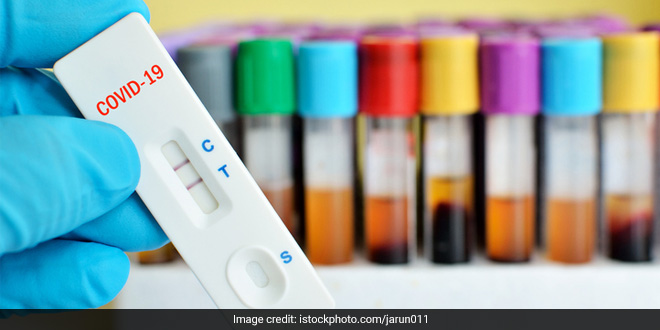Highlights
- One of the common tests for COVID-19 is the RT-PCR test
- RT-PCR test involves taking nasopharyngeal swab from patients
- Scientists have developed a more robust process to analyse COVID samples
Washington: Scientists, including one of Indian-origin, have developed a prototype of a rapid COVID-19 test using a simple-to-use portable instrument for reading the results with a smartphone in 30 minutes, an innovation that may enable point-of-care diagnosis without needing to send samples to a lab. According to the study, published in the journal Proceedings of the National Academy of Sciences (PNAS), the new technology may help overcome bottlenecks in supplies and laboratory personnel which have led to long waiting times for COVID-19 test results in several parts of the world amidst the ongoing pandemic.
Also Read: Indians Anywhere Can Access COVID-19 Lab In Three Hours: Union Health Minister Harsh Vardhan
If such a device and test were available, we could test for COVID-19 at public events, auditoriums, large gatherings and potentially even at home for self-testing. The results could be sent back to the appropriate public health system for coordination, said Rashid Bashir, a professor of bioengineering at the University of Illinois, Urbana-Champaign in the US.
In one of the common methods to test for the novel coronavirus SARS-CoV-2, healthcare workers take a sample from patients with a long nasopharyngeal swab, which is put into a substance called viral transport media, and send to a lab for extracting, isolating, and multiplying the viral genetic material, the scientists said. This viral RNA multiplication process, called RT-PCR, requires several temperature fluctuation cycles, specialised equipment, and trained personnel, said Brain Cunningham, another co-author of the study.
Also Read: Experts Explain The Different COVID-19 Tests: Rapid Antigen Vs RT-PCR Test, Which Is Better?
In the current research, the scientists used a simpler process to analyse the viral transport media, called LAMP, which bypasses the RNA extraction and purification steps.
“LAMP only needs one temperature — 65 C — so it is much easier to control,” said Anurup Ganguli, the first author of the study.
Also, LAMP works more robustly than PCR, especially when there are contaminants in the test sample. We can just briefly heat the sample, break open the virus, and detect the genetic sequence that specifically identifies SARS-CoV-2, Anurup Ganguli said.
When the researchers compared the LAMP assay with PCR, they found the results were in agreement, following which they documented the sensitivity and specificity of the LAMP test. The scientists then incorporated the assay onto a small 3D-printed cartridge that has two input slots for syringes — one for the sample-containing viral transport media, one for the LAMP chemicals. Once the two syringe components are injected, they the react within the cartridge, the study noted.
We use modern, high speed additive manufacturing to make these cartridges. The entire thing can be quickly scaled up to hundreds of thousands of tests, said Bill King, another co-author of the study from the University of Illinois.
“Production scale-up is typically the biggest obstacle for commercial applications of microfluidic cartridges, and we can overcome that obstacle using this new approach. Modern additive manufacturing is elastic and scalable, and it can be ramped up very quickly compared with legacy manufacturing technologies,” Bill King said.
According to the researchers, the cartridge can be inserted into a hand-held portable instrument with a heating chamber, which heats the cartridge to 65 degrees Celsius for the duration of the reaction, and a smartphone cradle is in place for reading the results. In approximately 30 minutes, a positive result will emit fluorescent light, they said.
The reader illuminates the liquid compartments with light from blue LEDs, while the phone’s rear-facing camera records a movie of the green fluorescent light being generated, Cunningham explained.
The scientists noted that they are currently assessing whether the assay would work with saliva samples to eliminate the need for nasopharyngeal swabs.
Also Read: New Study Ranks Performance Of Available COVID-19 Antibody Tests
(Except for the headline, this story has not been edited by NDTV staff and is published from a syndicated feed.)
NDTV – Dettol Banega Swasth India campaign is an extension of the five-year-old Banega Swachh India initiative helmed by Campaign Ambassador Amitabh Bachchan. It aims to spread awareness about critical health issues facing the country. In wake of the current COVID-19 pandemic, the need for WASH (Water, Sanitation and Hygiene) is reaffirmed as handwashing is one of the ways to prevent Coronavirus infection and other diseases. The campaign highlights the importance of nutrition and healthcare for women and children to prevent maternal and child mortality, fight malnutrition, stunting, wasting, anaemia and disease prevention through vaccines. Importance of programmes like Public Distribution System (PDS), Mid-day Meal Scheme, POSHAN Abhiyan and the role of Aganwadis and ASHA workers are also covered. Only a Swachh or clean India where toilets are used and open defecation free (ODF) status achieved as part of the Swachh Bharat Abhiyan launched by Prime Minister Narendra Modi in 2014, can eradicate diseases like diahorrea and become a Swasth or healthy India. The campaign will continue to cover issues like air pollution, waste management, plastic ban, manual scavenging and sanitation workers and menstrual hygiene.
[corona_data_new]





























